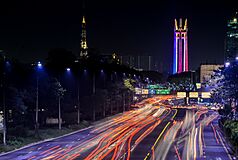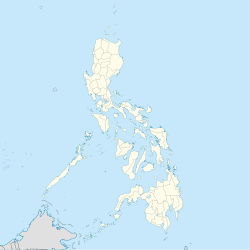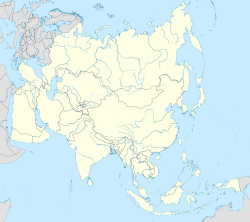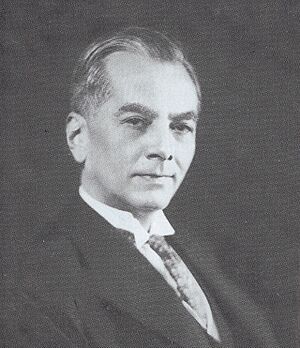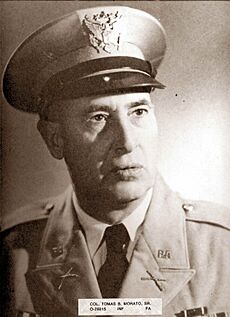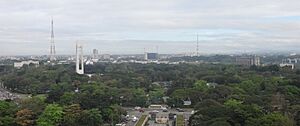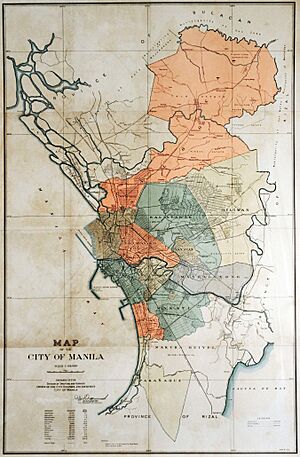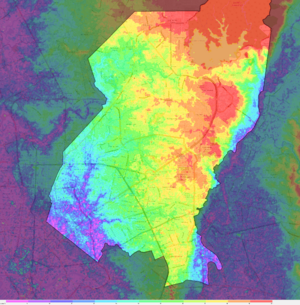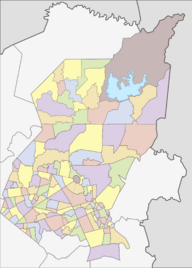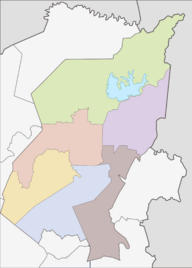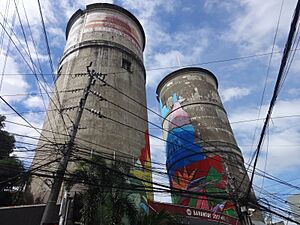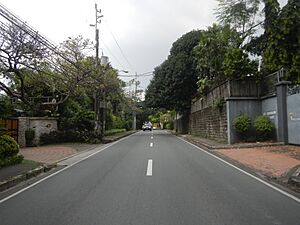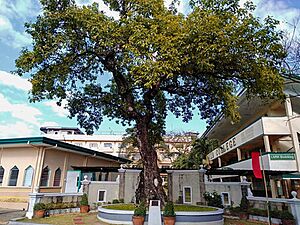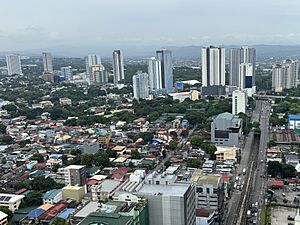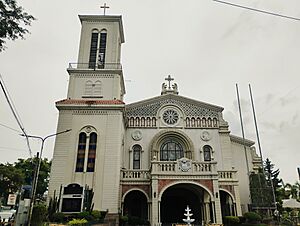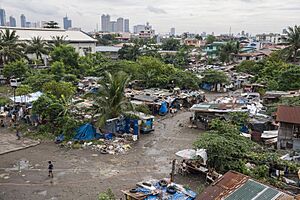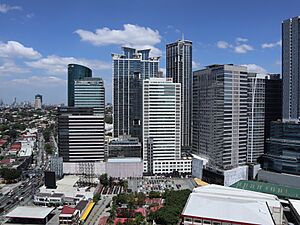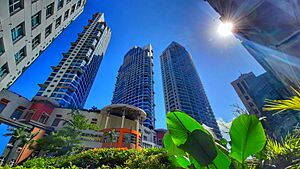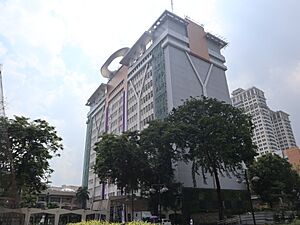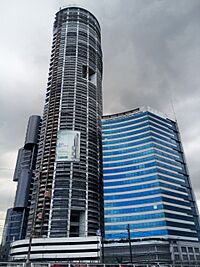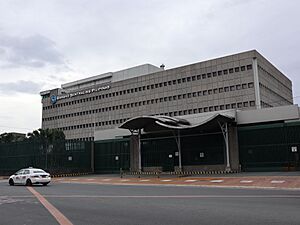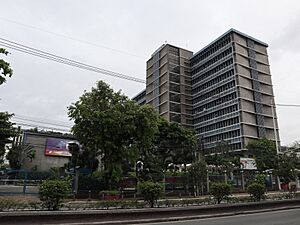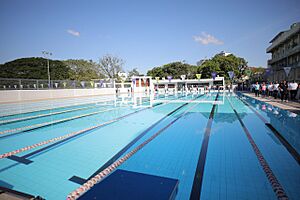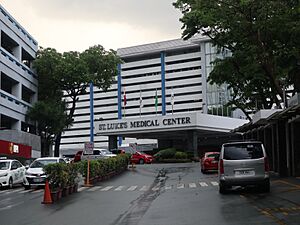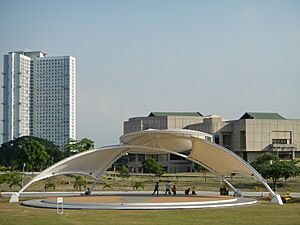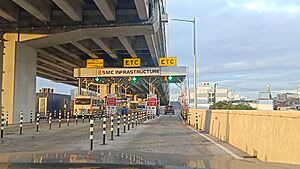Quezon City facts for kids
Quick facts for kids
Quezon City
|
|||
|---|---|---|---|
|
Highly urbanized city
|
|||
|
Commonwealth Avenue and Quezon Memorial Shrine
Ninoy Aquino Parks and Wildlife Center
Quezon City Hall
University of the Philippines Diliman
Eastwood City
Banawe Street
Araneta Coliseum
|
|||
|
|||
| Nickname(s):
City of Stars
|
|||
| Anthem: Awit ng Lungsod Quezon (Song of Quezon City) |
|||
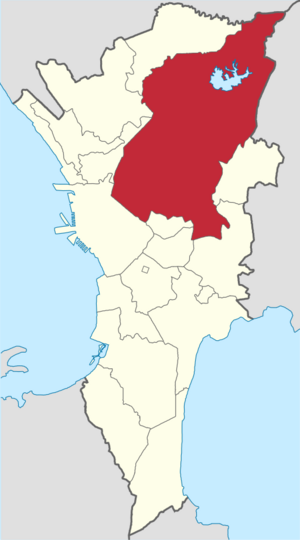
Map of Metro Manila with Quezon City highlighted
|
|||
|
OpenStreetMap
|
|||
| Country | |||
| Region | National Capital Region | ||
| Province | none | ||
| Districts | 1st to 6th districts | ||
| Incorporated (city) | October 12, 1939 | ||
| Highly urbanized city | December 22, 1979 | ||
| Named for | Manuel L. Quezon | ||
| Barangays | 142 (see Barangays) | ||
| Government
|
|||
| • Type | Sangguniang Panlungsod | ||
| Area | |||
| • Total | 171.71 km2 (66.30 sq mi) | ||
| Elevation | 67 m (220 ft) | ||
| Highest elevation | 796 m (2,612 ft) | ||
| Lowest elevation | -2 m (−6.6 ft) | ||
| Population
(2020 census)
|
|||
| • Total | 2,960,048 | ||
| • Rank | 1st | ||
| • Density | 17,238.6/km2 (44,647.9/sq mi) | ||
| • Households | 738,724 | ||
| Demonym(s) | Taga-QC QCitizen |
||
| Economy | |||
| • Income class | 1st city income class | ||
| • Poverty incidence |
|
||
| • Revenue | ₱ 26,462 million (2022) | ||
| • Assets | ₱ 441,279 million (2022) | ||
| • Expenditure | ₱ 25,352 million (2022) | ||
| • Liabilities | ₱ 27,723 million (2022) | ||
| Service provider | |||
| • Electricity | Manila Electric Company (Meralco) | ||
| Time zone | UTC+8 (PST) | ||
| ZIP code |
1100 to 1138
|
||
| PSGC |
[https://psa.gov.ph/classification/psgc/?q=psgc/barangays/{{#pro000®code={{&provcode=
|
||
| IDD : area code | +63 (0)2 | ||
| Native languages | Tagalog | ||
| Major religions | Catholic | ||
| Catholic diocese | Roman Catholic Diocese of Cubao, Roman Catholic Diocese of Novaliches | ||
| Patron saint | Our Lady of La Naval de Manila | ||
| Website | quezoncity |
||
Quezon City (often called Q.C. or Kyusi by locals) is the largest and most populated city in the Philippines. As of 2024, it has over 3 million people living there. The city was started on October 12, 1939, and was named after Manuel L. Quezon, who was the second president of the Philippines. Quezon City was the capital of the Philippines from 1948 to 1976. After that, Manila became the capital again.
The idea for Quezon City was to create a new national capital because Manila was getting too crowded. Manila had problems like not enough homes, poor sanitation, and lots of traffic. To make Quezon City, land was taken from nearby towns like Caloocan, Marikina, San Juan, and Pasig. The Philippine government also bought large areas of land for this purpose.
Quezon City became the official national capital on October 12, 1949. Many government offices moved there from Manila. This led to the city growing even more, with parts of Novaliches (from Caloocan), San Mateo, and Montalban being added. However, in 1976, Manila was made the capital again. Today, Quezon City is still a very important city and a big part of Metro Manila.
Quezon City is famous for its culture, entertainment, and media. It's often called the "City of Stars" because many major TV and radio networks have their main offices and studios here. The city is also a center for business, education, research, technology, and sports. Many national government offices, including the Batasang Pambansa Complex (where the Philippine House of Representatives meets), are located in Quezon City.
Quezon City was planned carefully. It covers about 161.11 square kilometers, making it the largest city in Metro Manila by land area. It is divided into six districts, each with its own representative in the Congress of the Philippines. The city also has 142 smaller areas called barangays. Much of the northern part of the city is near the Sierra Madre mountain range. This includes the La Mesa Watershed Reservation, which is the largest watershed in Metro Manila and a protected natural area.
Contents
History of Quezon City
How the City Began
Before Quezon City was created, the land it now sits on was part of several towns. These included Caloocan, Marikina, Montalban, Pasig, San Mateo, and San Juan del Monte. These towns were first part of Manila province and later Rizal province.
In the 1930s, Manila had many urban problems. There wasn't enough public housing, and many people lived in crowded areas. Sanitation and traffic were also big issues. To help, President Manuel L. Quezon started housing projects called Barrio Obrero (Worker's Community). But these projects didn't work out as planned and became crowded areas.
President Quezon wanted to build a new city where ordinary people could live comfortably. Alejandro Roces Sr., a famous Filipino writer, helped Quezon with this idea. Roces suggested buying a large piece of land for the new city. The government didn't have much money, but the National Development Company (NDC) had some funds.
To make Quezon's dream happen, the People's Homesite Corporation (PHC) was formed in 1938. PHC bought a huge area called the Diliman Estate from the Tuason family. They divided the land into smaller lots and sold them at affordable prices. The goal was to provide good, affordable homes for Manila's working class. Water services and new roads were also built in the area.
Eight large estates were bought to create Quezon City. These included Diliman Estate, Santa Mesa Estate, and San Francisco Del Monte Estate. President Quezon also wanted the University of the Philippines to move from Manila to a larger, more suitable location. In 1939, a law was passed to move the university to a new campus, which became part of Quezon City.
Founding the City
With new housing and the university campus being built, the creation of Quezon City made sense. On October 12, 1939, a law called Commonwealth Act No. 502 was passed, officially creating Quezon City. The city was originally going to be called Balintawak City. However, lawmakers decided to name it after President Quezon to honor his efforts.
The creation of Quezon City changed the plans for Manila. Money was redirected to build the new capital. Many areas from different towns were included in Quezon City. For example, parts of Caloocan, San Juan, Marikina, and Pasig became part of the new city. In 1941, some boundaries were adjusted again.
In 1939, Quezon City had about 39,103 people. It was mostly a rural area back then. President Quezon asked American architect William Parsons to create a master plan for the city. Parsons suggested placing the main government center in Diliman, away from Manila Bay, for safety. After Parsons passed away, his partner Harry T. Frost continued the work.
The "Frost Plan" for Quezon City was approved in 1941. It featured wide roads, large open spaces, and roundabouts. The center of the city was a 400-hectare quadrangle, planned to be the location for the national government buildings. This included a Capitol Building and offices for government leaders.
World War II and After
In 1942, during World War II, President Quezon created the City of Greater Manila as an emergency measure. This merged Quezon City with Manila and several other towns. The Japanese military used some facilities in Quezon City as hospitals during the war. After the war, the City of Greater Manila was dissolved, and Quezon City returned to its previous status.
On July 17, 1948, President Elpidio Quirino signed a law making Quezon City the new capital of the Philippines. The city expanded northward, taking in areas from Novaliches that were previously part of Caloocan. This change divided Caloocan into two separate parts. Quezon City was officially opened as the capital on October 12, 1949.
The city's boundaries were changed a few more times in the 1950s. Today, Quezon City covers about 161.11 square kilometers, making it the largest local government unit in Metro Manila by land area.
Changes in the 1960s and 1970s
The 1960s and 1970s brought many changes to the Philippines. Students from universities in Quezon City, like the University of the Philippines Diliman, were among the first to speak out for change. They protested against government policies and called for reforms.
One important event was the "First Quarter Storm" in 1970, where students held major protests. In 1971, the "Diliman Commune" happened, where students and faculty at UP Diliman protested against an oil price increase and demanded that the military not attack the campus.
When Ferdinand Marcos declared martial law in September 1972, many media outlets in Quezon City were shut down. Many students, journalists, and politicians who opposed Marcos were arrested. Camp Crame in Quezon City became a place where many political prisoners were held.
Monuments like the Bantayog ng mga Bayani were later built in Quezon City to honor those who fought for freedom during this time. The funeral of Ninoy Aquino, a famous opposition leader, started at his family's home in Quezon City in August 1983. Millions of people joined the procession, which helped inspire more protests against the government.
In 1975, Metro Manila was created as a single unit of government. In 1976, Manila was made the capital of the Philippines again because of its historical importance. President Marcos also ordered the remains of President Quezon to be moved to the newly finished Quezon Memorial Shrine in 1978.
Recent History
In 1986, the peaceful People Power Revolution took place, which led to Marcos leaving power. Thousands of people gathered on EDSA (Epifanio de los Santos Avenue) in Quezon City, between Camp Crame and Camp Aguinaldo, to protest. This event happened from February 22 to 25, 1986.
Today, three major monuments remembering the Martial Law era are in Quezon City. The People Power Monument and the EDSA Shrine were built to remember the revolution. The Bantayog ng mga Bayani honors the heroes who struggled during the Marcos era.
In 1998, there was a plan to create a new city called Novaliches from 15 northern barangays of Quezon City. However, in a vote held in 1999, most Quezon City residents voted against Novaliches becoming a separate city.
In 2010, actor Herbert Bautista became the city mayor. During his time, the Quezon City Pride Council, the first LGBT council in the Philippines, was created. He also started housing projects called "Bistekville." In 2019, Joy Belmonte became the city mayor and was reelected in 2022. She established the Quezon City People's Council to encourage more citizen participation in government.
From March 2020, Quezon City, like other areas, was placed under community quarantine due to the COVID-19 pandemic. The strictest quarantine measures were in 2020 and 2021. These measures were gradually eased until the public health emergency was lifted in July 2023.
On June 15, 2025, a civil servant was killed in Barangay Commonwealth. Police believe the incident was carefully planned. The House Speaker Martin Romualdez condemned the act and called for a thorough investigation.
Geography of Quezon City
Quezon City has rolling hills and varied land. It is part of the area drained by five river systems: Marikina, Pasig, San Juan, Tullahan, and Meycauayan. These rivers have many smaller streams and tributaries. The city covers about 161.11 square kilometers, making it the largest city in Metro Manila by land area.
Quezon City is bordered by Rodriguez and San Jose del Monte to the north, Marikina and San Mateo to the east, Pasig to the southeast, Mandaluyong and San Juan to the south, Manila to the southwest, and Caloocan and Valenzuela to the west and northwest. The city sits on the Guadalupe Plateau, which is a higher area between the lowlands of Manila and the Marikina River Valley. The highest point in Quezon City is in the northern part of the La Mesa Watershed Reservation, about 250 meters above sea level. The West Valley Fault runs along the eastern edge of the city.
Barangays and Congressional Districts
Right: The six legislative districts of Quezon City.
Quezon City is divided into 142 barangays. These barangays are grouped into six congressional districts. Each district has a representative in the House of Representatives and six City Councilors.
- District I includes 37 barangays like Alicia, Bagong Pag-asa, and Bahay Toro. It covers about 19.59 square kilometers.
- District II has 5 barangays, including Bagong Silangan, Batasan Hills, and Commonwealth. It is the largest district in terms of land area.
- District III covers 37 barangays such as Amihan, Bagumbuhay, and Camp Aguinaldo.
- District IV has 38 barangays, including Bagong Lipunan ng Crame, Botocan, and Central.
- District V is often called Novaliches. It has 14 barangays like Bagbag, Capri, and Fairview.
- District VI includes 11 barangays such as Apolonio Samson, Baesa, and Culiat.
Climate in Quezon City
| Weather chart for Quezon City | |||||||||||||||||||||||||||||||||||||||||||||||
|---|---|---|---|---|---|---|---|---|---|---|---|---|---|---|---|---|---|---|---|---|---|---|---|---|---|---|---|---|---|---|---|---|---|---|---|---|---|---|---|---|---|---|---|---|---|---|---|
| J | F | M | A | M | J | J | A | S | O | N | D | ||||||||||||||||||||||||||||||||||||
|
27
31
21
|
24
32
22
|
33
33
23
|
42
35
24
|
212
34
25
|
323
33
25
|
517
32
25
|
569
31
25
|
500
32
24
|
284
32
24
|
141
32
23
|
115
31
22
|
||||||||||||||||||||||||||||||||||||
| temperatures in °C precipitation totals in mm source: PAGASA |
|||||||||||||||||||||||||||||||||||||||||||||||
|
Imperial conversion
|
|||||||||||||||||||||||||||||||||||||||||||||||
Quezon City has a tropical monsoon climate. This means it has a dry season from December to April and a long wet season from May to November, which brings heavy rains.
The main weather station for the city is at the PAGASA Science Garden. Temperatures can range from a high of 38.5°C to a low of 14.9°C. The hottest time is from April to May, with an average daily high of 32.8°C. The cooler season is from November to February, with average temperatures below 30.5°C.
About 20 typhoons enter the Philippines each year, affecting Quezon City and Metro Manila. Heavy rains from the Habagat (southwest monsoon) can also cause floods and landslides, especially for people living near rivers.
| Climate data for Science Garden, Quezon City (1991–2020, extremes 1961–2024) | |||||||||||||
|---|---|---|---|---|---|---|---|---|---|---|---|---|---|
| Month | Jan | Feb | Mar | Apr | May | Jun | Jul | Aug | Sep | Oct | Nov | Dec | Year |
| Record high °C (°F) | 34.7 (94.5) |
35.6 (96.1) |
36.8 (98.2) |
38.2 (100.8) |
38.5 (101.3) |
38.0 (100.4) |
36.2 (97.2) |
36.1 (97.0) |
35.6 (96.1) |
35.4 (95.7) |
35.0 (95.0) |
34.9 (94.8) |
38.5 (101.3) |
| Mean daily maximum °C (°F) | 30.6 (87.1) |
31.5 (88.7) |
32.9 (91.2) |
34.6 (94.3) |
34.4 (93.9) |
33.1 (91.6) |
31.8 (89.2) |
31.2 (88.2) |
31.5 (88.7) |
31.7 (89.1) |
31.6 (88.9) |
30.7 (87.3) |
32.1 (89.8) |
| Daily mean °C (°F) | 26.0 (78.8) |
26.5 (79.7) |
27.8 (82.0) |
29.4 (84.9) |
29.8 (85.6) |
29.1 (84.4) |
28.2 (82.8) |
27.9 (82.2) |
27.9 (82.2) |
27.8 (82.0) |
27.4 (81.3) |
26.6 (79.9) |
27.8 (82.0) |
| Mean daily minimum °C (°F) | 21.4 (70.5) |
21.5 (70.7) |
22.6 (72.7) |
24.1 (75.4) |
25.1 (77.2) |
25.0 (77.0) |
24.5 (76.1) |
24.6 (76.3) |
24.4 (75.9) |
23.9 (75.0) |
23.2 (73.8) |
22.4 (72.3) |
23.6 (74.5) |
| Record low °C (°F) | 15.5 (59.9) |
15.1 (59.2) |
14.9 (58.8) |
17.2 (63.0) |
17.8 (64.0) |
18.1 (64.6) |
17.7 (63.9) |
17.8 (64.0) |
20.0 (68.0) |
18.6 (65.5) |
15.6 (60.1) |
15.1 (59.2) |
14.9 (58.8) |
| Average rainfall mm (inches) | 27.1 (1.07) |
24.4 (0.96) |
32.9 (1.30) |
41.7 (1.64) |
211.9 (8.34) |
322.7 (12.70) |
516.6 (20.34) |
568.5 (22.38) |
500.3 (19.70) |
283.6 (11.17) |
141.4 (5.57) |
114.5 (4.51) |
2,785.6 (109.67) |
| Average rainy days (≥ 1.0 mm) | 4 | 3 | 4 | 5 | 12 | 17 | 21 | 21 | 21 | 15 | 12 | 8 | 143 |
| Average relative humidity (%) | 77 | 73 | 70 | 68 | 73 | 79 | 83 | 85 | 84 | 82 | 81 | 80 | 78 |
| Source: PAGASA | |||||||||||||
City Districts
Quezon City is divided into six official legislative districts. However, it also has older, informal districts based on its history. For example, San Francisco del Monte was originally a town founded by Franciscan missionaries. The Diliman Quadrangle was planned to be the city's main center.
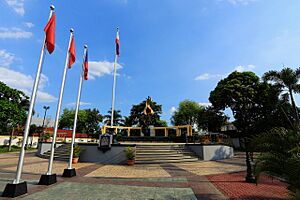
- Bago Bantay: This is a residential area in the west-central part of the city, located behind SM North EDSA. It includes barangays like Alicia and Ramon Magsaysay.
- Cubao: Located in the southern part of the city, Cubao is home to Araneta City, a large area with shopping malls like Ali Mall and Gateway Mall. It also has the famous Smart Araneta Coliseum. The Cubao Cathedral is an important church here.
- Diliman: This area is in the center of Quezon City, where the city was first established. Many national government offices and major universities like the University of the Philippines Diliman are located here. The Diliman Quadrangle is known for its hospitals, government buildings, and lively nightlife. Major TV networks like ABS-CBN and GMA have their main offices in Diliman.
- Galas: This district is on the southwest border of Quezon City, next to Manila. It includes barangays named after important people in the city's early days.
- La Loma: Located in the southwestern part of the city, La Loma is famous for its delicious lechon (roasted pig). The nearby La Loma Cemetery is named after this area.
- New Manila: This area is named after Manila because many wealthy families from Manila moved here to escape the city's busy life. It was once part of San Juan. New Manila is also known for Balete Drive, a street famous in Filipino folklore for ghost stories.
- Novaliches: This is the largest district in Quezon City. It covers most of the northern part of the city and includes the La Mesa Watershed Reservation, which supplies much of Metro Manila's water. Novaliches was originally part of Caloocan before joining Quezon City in 1948.
- Project 1: Also known as Barangay Roxas, this was the first housing project started by the Philippine Homesite Housing Corporation in 1948.
- Project 2: This area includes barangays Quirino 2-A, Quirino 2-B, and Quirino 2-C, and is known as Anonas.
- Project 3: This area includes barangays Quirino 3-A, Amihan, Claro, and Duyan-Duyan, also known as Anonas.
- Project 4: Located in the eastern part of the city, next to Cubao.
- Project 5: Also known as Barangay E. Rodriguez.
- Project 6: This is a well-off barangay in Diliman, known for hospitals like the Philippine Children's Medical Center and the Veterans Memorial Medical Center. It's also home to the Philippine Science High School Main Campus.
- Project 7: This area includes barangays Bungad and Veterans Village.
- Project 8: This area includes barangays Bahay Toro, Baesa, and Sangandaan.
- San Francisco del Monte: Founded in 1590, this is Quezon City's oldest district. It was originally a town started by Franciscan missionary Saint Pedro Bautista. It has hilly areas and is home to the old Santuario de San Pedro Bautista church.
- Santa Mesa Heights: This is a wealthy neighborhood, mostly residential. It is home to important churches like the National Shrine of Our Lady of Lourdes and the National Shrine of Our Lady of La Naval. Many Catholic schools are also located here. Banawe Street, known for its Asian restaurants, is in this area.
- Quezon City Chinatown is the largest Chinatown in the world, covering about 591.9 hectares. It was officially created in 2005 and declared a Tourism District in 2015.
Cityscape and Architecture
City Design

Quezon City has many different architectural styles, including Art Deco, Brutalist, and modern designs. It also has many monuments and museums. When the city was created in 1939, Art Deco was a popular style. The goal was to show that the Philippines was moving forward and preparing for independence.
The Quezon Memorial Shrine, built from 1952 to 1978, is an example of Art Deco style. It is a symbol of the city and has a museum and mausoleum for President Manuel L. Quezon and his wife Aurora. When Quezon City became the capital in 1948, many government buildings moved there.
During the time of President Ferdinand Marcos, many government hospitals were built in the city, like the Lung Center of the Philippines and the Philippine Heart Center. These were known as "designer" hospitals. Traditional Filipino designs were also used in buildings like the Batasang Pambansa Complex, which was inspired by the Bahay Kubo (a traditional Filipino house).
Master Plans for the City
In 1938, President Manuel L. Quezon decided to create a new capital city. Manila was becoming too crowded, and his military advisors suggested a new capital should be further from Manila Bay to be safer from attacks. Quezon asked American architect William E. Parsons to help choose a location. Parsons chose the Diliman (Tuason) estate.
Parsons passed away in 1939, and his partner Harry Frost took over. Frost worked with other architects and planners to create a grand master plan for the new capital, which was approved in 1941. The plan included a large 400-hectare Central Park, similar in size to New York's Central Park.
At the heart of this plan was a 25-hectare elliptical area, meant to be the site of a large Capitol Building for the Philippine Legislature. The new Malacañang Palace (for the President) and the Supreme Court were also planned to be nearby. This design aimed to place all three branches of government close together for efficiency.
Population and People
According to the 2020 Philippine census, Quezon City has 2,960,048 people. This makes it the most populous city in the Philippines. In 2015, about one-fourth of Metro Manila's population lived in Quezon City. The city has grown a lot since it was founded in 1939 with only 39,013 people. By 1980, its population reached over one million, and by 2000, it was over two million.
The average household in Quezon City has 4.3 members. The population is generally young, with an average age of 28 years. Females make up slightly more than half of the population (50.71%). Children and youth (ages 0–30) make up more than half of the city's total population.
Tagalog is the most spoken language in Quezon City, used by about 46.78% of the people. Other languages spoken include Bisaya/Binisaya, Bikol, Ilocano, and Hiligaynon/Ilonggo.
Religions in Quezon City
Religion in Quezon City Catholicism (86.25%) Protestantism (5.63%) Iglesia ni Cristo (4.62%) Islam (1.1%) Other / non-affiliated (2.4%)

Quezon City is mainly a Roman Catholic city, with about 86.25% of its population following this religion. The city is home to the main offices of the Roman Catholic Dioceses of Cubao and Novaliches.
Many different Protestant faiths also have a strong presence in Quezon City. The main offices of groups like the National Council of Churches in the Philippines (NCCP) and the United Church of Christ in the Philippines (UCCP) are located here. The third largest religion is Iglesia ni Cristo, whose Central Temple is in New Era. There is also a notable Islamic population in the city.
Housing and Communities
|
||||
As of 2013, there were many families in Quezon City living in informal settlements. Many of these families lived near waterways or in other unsafe areas.
The Quezon Task Force on Socialized Housing and Development of Blighted Areas helps address housing needs in the city. Their goal is to provide safe and decent homes for families living in informal settlements. This program involves different government agencies and private groups working together. The city's main housing program is called Bistekville communities.
Economy
Quezon City is a major center for business and trade in the Philippines. It is important for banking, shopping, transportation, tourism, real estate, and entertainment. It is also a hub for media, technology, and various services like healthcare and law.
The National Competitiveness Council of the Philippines has ranked Quezon City as one of the most competitive cities in the country from 2015 to 2019. It even received a "Hall of Fame Award" in 2020 for its consistent high performance. This means it's a great place to live and do business. There are about 86,000 registered businesses in the city. Since 2020, Quezon City has been the richest city in the Philippines. By the end of 2023, the city's total assets were about ₱448.51 billion.
Technology and Communication
Quezon City calls itself the ICT (Information and Communications Technology) capital of the Philippines. It was the first local government unit in the country to have a computerized system for property assessment and payments.
The city has 33 ICT parks, including the Eastwood City Cyberpark in Bagumbayan. This is the first and largest IT Park in the Philippines. The main offices of the Department of Information and Communications Technology and the National Telecommunications Commission are also located in Quezon City.
Media and Entertainment

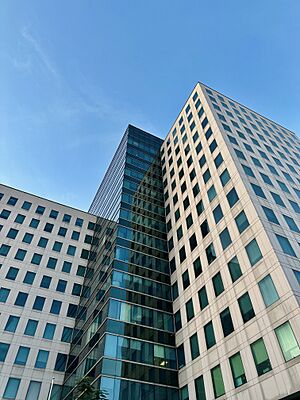
Quezon City is known as the "Entertainment Capital of the Philippines" and the "City of Stars." This is because many major film studios are located here, and many Filipino actors and actresses live in the city. To support the film industry, the city has the Quezon City Film Development Commission. The city also hosts its own film festival, the QCinema International Film Festival, which shows local and international films.
Quezon City is home to the Philippines' biggest TV and radio networks. There are 11 local TV networks, 6 cable TV channels, 7 AM radio stations, and 4 FM radio stations in the city. Major networks like ABS-CBN and GMA Network have their main offices here. State-owned networks like RPN, IBC, and PTV also have their headquarters in the city.
Other broadcasting companies, including religious ones like CEBSI (Net 25) and UNTV, also have their main offices in Quezon City. The Net 25 Tower in the city is the tallest communications tower in the Philippines.
Government
Local Government
Quezon City is a "Special City" and a "highly urbanized city." The mayor is the chief leader of the city and is part of the Metro Manila Council. The mayor is helped by the vice mayor, who leads the 38-member Quezon City Council. The council members are elected from the city's six districts.
The current mayor is Maria Josefina "Joy" Belmonte. She was previously the city's vice mayor and is the daughter of former mayor and House Speaker Feliciano Belmonte Jr.. The current vice mayor is Gian Sotto, who is the son of actors Tito Sotto and Helen Gamboa. The mayor and vice mayor can serve up to three terms, with each term lasting three years.
From 1939 to 1959, Quezon City mayors were chosen by the President. Norberto S. Amoranto was the first elected mayor and served the longest, for 22 years.
Quezon City celebrates national holidays. Quezon City Day, celebrated every August 19, is a special non-working holiday. It honors the birthday of Manuel L. Quezon.
National Government Offices
As a former capital, Quezon City is home to many national government offices and agencies. The House of Representatives of the Philippines (the Lower House of Congress) is located here. Several government departments also have their main offices in the city, including the Department of Agrarian Reform, Agriculture, Environment and Natural Resources, and Interior and Local Government.
Independent government bodies like the Commission on Audit and the Office of the Ombudsman are also in Quezon City. Special courts, such as the Court of Tax Appeals and the Sandiganbayan, are located here too.
The city has two main National Government Centers (NGC). The first is in the Diliman Quadrangle. This area was originally planned for the Capitol Building, the Executive Mansion, and the Supreme Court. Today, it houses departments like Agrarian Reform, Agriculture, Environment and Natural Resources, and Interior and Local Government. Other agencies like the Bureau of Internal Revenue and the Social Security System are also located here.
The second National Government Center is along Commonwealth Avenue in Batasan Hills. This is where the Batasang Pambansa Complex is located. The Commission on Audit and the Sandiganbayan are also found here.
Sports
Quezon City has a rich history in sports. It is home to important sports venues like the Amoranto Sports Complex and the Smart Araneta Coliseum. The famous boxing match between Muhammad Ali and Joe Frazier, known as the "Thrilla in Manila", was held at the Araneta Coliseum. This match was watched by over a billion people worldwide.
The city has also hosted events for the Southeast Asian Games in 1981, 1991, 2005, and 2019. The Araneta Coliseum has hosted many basketball games, including the FIBA Basketball World Cup in 1978 and 2023.
Basketball is very popular in the Philippines. Most barangays in Quezon City have basketball courts, and larger ones have covered courts for local leagues. The city also has professional basketball teams, like the Quezon City Toda Aksyon, which joined the Maharlika Pilipinas Basketball League in 2018.
Quezon City also has golf courses, such as the Veterans Memorial Golf Club and Camp Aguinaldo Golf Club. The Capitol Hills Golf & Country Club is a private 18-hole golf course with views of the Marikina Valley.
Healthcare
The Quezon City Health Department is in charge of public health in the city. It has 60 government and private hospitals. There are three city-owned hospitals: Quezon City General Hospital, Novaliches District Hospital, and Rosario Maclang Bautista General Hospital. Another city-owned hospital, the Visayas Avenue Medical Center, is currently being built.
The national government operates several hospitals in Quezon City. These include the East Avenue Medical Center (EAMC), Quirino Memorial Medical Center, and the Veterans Memorial Medical Center (VMMC). There are also specialty hospitals like the Lung Center of the Philippines, National Kidney and Transplant Institute (NKTI), and Philippine Heart Center. For children, there's the Philippine Children's Medical Center and the National Children's Hospital. The Armed Forces of the Philippines runs the V. Luna General Hospital.
Many private hospitals also provide healthcare in the city. These include St. Luke's Medical Center – Quezon City, which is known as one of the best private hospitals in the country.
Education
Quezon City, along with Manila, is a major center for education in the Philippines. The Schools Divisions Office of Quezon City (SDO QC) manages 97 public elementary schools and 46 public high schools. The number of students in public schools has grown a lot over the years. Quezon City has the most public schools in the Philippines.
The Quezon City Science High School (QueSci) has been the Regional Science High School for Metro Manila since 1998. The city is also home to the Philippine Science High School Main Campus, which is a top science school in the country.
The Quezon City Science Interactive Center is the first of its kind in the Philippines, offering hands-on science learning. The Quezon City Public Library (QCPL) has 20 branches across the city, with its main library at the Quezon City Hall Complex.
Colleges and Universities
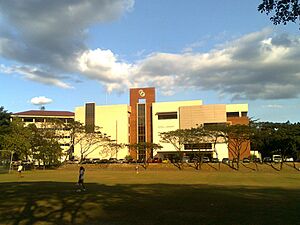
Quezon City has two state universities: the University of the Philippines Diliman (UPD) and a branch campus of the Polytechnic University of the Philippines. The city also has its own university, the Quezon City University (QCU), with three campuses.
Many private universities are located here, such as AMA Computer University, Central Colleges of the Philippines (CCP), and the Technological Institute of the Philippines (TIP).
Quezon City also hosts well-known Catholic schools like Ateneo de Manila University (AdMU), St. Paul University Quezon City, and UST Angelicum College. Other religious universities, like the Evangelical Grace Christian College and the Iglesia ni Cristo founded New Era University (NEU), are also in the city.
Because of its many medical schools, Quezon City is also a center for medical education. These include FEU Nicanor Reyes Medical Foundation and St. Luke's College of Medicine.
Transportation
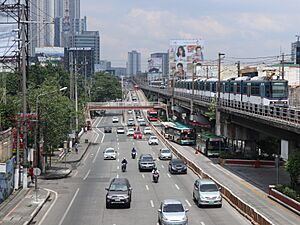
Transportation in Quezon City is mainly by land. Most people use private cars, but public transport like jeepneys, city buses, and UV Express vans are also very common. These public vehicles follow set routes and have fixed prices. All public road transport in Quezon City is privately owned and operated under government permits. The city has also started using e-trikes in some areas to promote cleaner transportation.
The Metro Manila Skyway is an elevated expressway that passes through Quezon City, connecting the North and South Luzon Expressways. The city government also started its own bus service in 2021, called the "QCity Bus Service," which became a permanent program in 2023.
Railway Systems
Quezon City is served by several train lines: LRT Line 1, LRT Line 2, and MRT Line 3. LRT-1 runs along EDSA, and LRT-2 runs along Aurora Boulevard, connecting Quezon City to other cities. MRT-3 also runs along EDSA.
New train lines are being built in the city, including MRT Line 4, MRT Line 7, and the Metro Manila Subway. The North Triangle Common Station, which will connect Lines 1, 3, 7, and the Metro Manila Subway, is currently under construction.
Air Travel
The city is served by Ninoy Aquino International Airport to the south and Clark International Airport to the north. In the future, it will also be served by the new New Manila International Airport in the nearby province of Bulacan. All these airports are located outside Quezon City itself.
Utilities
Water, Power, and Telecom
Water services in Quezon City are provided by Maynilad Water Services for the west and north, and Manila Water for the southeast. The Novaliches-Balara Aqueduct 4 (NBAQ4), built by Manila Water, is a large water supply project in Metro Manila. The La Mesa Dam and Reservoir is located in the northern part of the city and is a major source of water. It also includes the La Mesa Watershed Reservation and Ecopark.
Electricity is provided by Meralco, the main electric power company in Metro Manila. As of 2009, Meralco had over 500,000 customers in the city. By October 2019, Quezon City had installed many LED streetlights.
With more companies offering phone and internet services, residents of Quezon City have more choices. Major telecommunication companies like PLDT/Smart Communications, Globe Telecom, and Dito Telecommunity operate in the city.
Waste Management
The Payatas dumpsite was once the largest landfill in Metro Manila. It was established in the 1970s in the barangay of Payatas. After the Smokey Mountain landfill in Manila closed in 1995, many people who worked there as scavengers moved to Payatas, creating a community around the dumpsite.
In July 2000, a tragic landslide occurred at the Payatas dumpsite when a large pile of garbage collapsed, causing a fire and killing many people. After this event, a law was passed requiring the closure of open dumpsites in the Philippines. The Payatas dumpsite was reconfigured as a controlled facility in 2004 but was fully closed in December 2010. A newer dumpsite was opened nearby in 2011 but also closed in December 2017.
Sister Cities
Asia
 Alicia, Isabela, Philippines
Alicia, Isabela, Philippines Banaybanay, Davao Oriental, Philippines
Banaybanay, Davao Oriental, Philippines Cagayan de Oro, Misamis Oriental, Philippines
Cagayan de Oro, Misamis Oriental, Philippines Calasiao, Pangasinan, Philippines
Calasiao, Pangasinan, Philippines Chiba, Japan
Chiba, Japan Cotabato City, Philippines
Cotabato City, Philippines Davao City, Philippines
Davao City, Philippines General Santos, Philippines
General Santos, Philippines Hagåtña, Guam
Hagåtña, Guam Iloilo City, Philippines
Iloilo City, Philippines La Trinidad, Benguet, Philippines
La Trinidad, Benguet, Philippines Puerto Princesa, Philippines
Puerto Princesa, Philippines Pura, Tarlac, Philippines
Pura, Tarlac, Philippines Roxas City, Philippines
Roxas City, Philippines Sadanga, Mountain Province, Philippines
Sadanga, Mountain Province, Philippines Shenyang, China
Shenyang, China Taipei, Taiwan
Taipei, Taiwan Wao, Lanao del Sur, Philippines
Wao, Lanao del Sur, Philippines Yangon, Myanmar
Yangon, Myanmar Yuci District, China
Yuci District, China
Americas
 Caracas, Venezuela
Caracas, Venezuela Daly City, California, United States
Daly City, California, United States Fort Walton Beach, Florida, United States
Fort Walton Beach, Florida, United States Kenosha, Wisconsin, United States
Kenosha, Wisconsin, United States Maui County, Hawaii, United States
Maui County, Hawaii, United States New Westminster, Canada
New Westminster, Canada Salt Lake City, Utah, United States
Salt Lake City, Utah, United States
International Connections
Affiliates
 Osaka, Japan (2018)
Osaka, Japan (2018) Pyeongchang County, South Korea
Pyeongchang County, South Korea
Consulates
| Country | Type | Ref. |
|---|---|---|
| Consular agency |
In Art
- Cubao Landscape, by Fernando Amorsolo, 1924.
- Novaliches Landscape, by Fernando Amorsolo, 1925.
- Landscape (The University of the Philippines Campus Site in Diliman), by Dominador Castañeda, 1941.
- Mira Nila, by Macario Vitalis, 1963.
Notable People
See also
 In Spanish: Ciudad Quezon para niños
In Spanish: Ciudad Quezon para niños
- Capital of the Philippines


